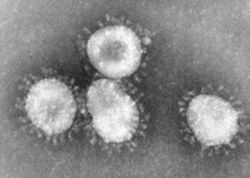- CoV
-
Coronavirus
Coronavirus

Coronavirus sp. Classification classique Règne Virus Groupe Groupe IV Ordre Nidovirales Famille Coronaviridae Genre Coronavirus Parcourez la biologie sur Wikipédia : Coronavirus est le nom d'un genre de virus de la famille des coronaviridae.
Sommaire
Liste des espèces
- genre Coronavirus :
- groupe 1
- coronavirus canin — Canine coronavirus (CCV)
- coronavirus félin FCoV : coronavirus félin entérique FECV, et coronavirus de la péritonite infectieuse féline FIPV — Feline coronavirus
- — Human coronavirus 229E (HCoV-229E)
- — Porcine epidemic diarrhea virus (PEDV)
- — virus de la gastroentérite transmissible du porc Transmissible gastroenteritis virus (TGEV)
- — Human Coronavirus NL63 (NL or New Haven)
- virus respiratoires porcins
- groupe 2
- coronavirus bovin — Bovine coronavirus (BCoV)
- coronavirus humain OC43 — Human coronavirus OC43 (HCoV-OC43)
- virus des hépatites murines — Murine hepatitis virus (MHV)
- — Porcine hemagglutinating encephalomyelitis virus (HEV)
- — Rat coronavirus (RCV)
- — Turkey coronavirus (TCoV)
- — (No common name as of yet) (HCoV-HKU1)
- virus de la silodacryonite du rat
- — Groupe 2b : Severe acute respiratory syndrome coronavirus (SARS-CoV)
- groupe 3
- virus de la bronchite infectieuse aviaire — Infectious bronchitis virus (IBV)
- coronavirus du dindon — Turkey coronavirus (Bluecomb disease virus)
- groupe 1
Replication
image [1]
The infection cycle of coronavirus
Replication of Coronavirus begins with entry to the cell takes place in the cytoplasm in a membrane-protected microenvironment, upon entry to the cell the virus particle is uncoated and the RNA genome is deposited into the cytoplasm. The Coronavirus genome has a 5’ methylated cap and a 3’polyadenylated-A tail to make it look as much like the host RNA as possible. This also allows the RNA to attach to ribosomes for translation. Coronaviruses also have a protein known as a replicase encoded in its genome which allows the RNA viral genome to be translated into RNA through using the host cells machinery. The replicase is the first protein to be made as once the gene encoding the replicase is translated the translation is stopped by a stop codon. This is known as a nested transcript, where the transcript only encodes one gene- it is monocistronic. The RNA genome is replicated and a long polyprotein is formed, where all of the proteins are attached. Coronaviruses have a non-structural protein called a protease which is able to separate the proteins in the chain. This is a form of genetic economy for the virus allowing it to encode the most amounts of genes in a small amount of nucleotides.
Coronavirus transcription involves a discontinuous RNA synthesis (template switch) during the extension of a negative copy of the subgenomic mRNAs. Basepairing during transcription is a requirement. Coronavirus N protein is required for coronavirus RNA synthesis, and has RNA chaperone activity that may be involved in template switch. Both viral and cellular proteins are required for replication and transcription. Coronaviruses initiate translation by cap-dependent and cap-independent mechanisms. Cell macromolecular synthesis may be controlled after Coronavirus infection by locating some virus proteins in the host cell nucleus. Infection by different coronaviruses cause in the host alteration in the transcription and translation patterns, in the cell cycle, the cytoskeleton, apoptosis and coagulation pathways, inflammation, and immune and stress responses.[4]
Voir aussi
Articles connexes
Liens externes
Bibliographie
Carrington CVF, Foster JE, Zhu HC, Zhang JX, Smith GJD, Thompson N, Auguste AJ, Ramkissoon V, Adesiyun AA & Guan Y (2008). Emerging Infectious Diseases (DOI: 10.3201/eid1412.080642).
Notes et références
Catégorie : Nidovirales - genre Coronavirus :
Wikimedia Foundation. 2010.
